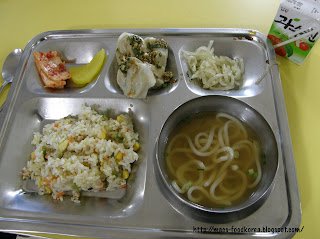Five days of Camp Food
http://stafford.squarespace.com/journal/2008/10/31/school-lunch-5.html
I am at camp for four weeks and although teaching cooking (Pancakes )
I am not getting to cook like I normally do so I got to focus on something else. So here it is some of the meals from my Five days Breakfast, Lunch and Dinner. You may know there is no difference in the breakfast lunch or dinner in Korea Its rice rice and rice .

 "Jajangmyeon (also spelled jjajangmyeon) is a Korean dish, derived from the Chinese dish zhajiang mian. It consists of wheat noodles topped with a thick sauce made of chunjang (a salty black soybean paste), diced meat and vegetables, and sometimes also seafood. Jajang (also spelled jjajang), name of the sauce, is the Korean pronunciation of the Chinese characters 炸醬, which literally means "fried sauce." Myeon (also spelled myun) means "noodle."
"Jajangmyeon (also spelled jjajangmyeon) is a Korean dish, derived from the Chinese dish zhajiang mian. It consists of wheat noodles topped with a thick sauce made of chunjang (a salty black soybean paste), diced meat and vegetables, and sometimes also seafood. Jajang (also spelled jjajang), name of the sauce, is the Korean pronunciation of the Chinese characters 炸醬, which literally means "fried sauce." Myeon (also spelled myun) means "noodle." DEOK MANDU GUK
DEOK MANDU GUKhttp://en.wikipedia.org/wiki/Mandu_(dumpling)
In Korean cuisine, mandu denotes a type of filled dumplings similar to the Turkish mantı, the Chinese jiaozi, and the Japanese gyoza. If the dumplings are grilled or fried, they are called gunmandu (군만두). Mandu are usually served with a dipping sauce made of soy sauce and vinegar.
RECIPE HERE

KOREAN CURRY
http://gastronomicaljourney.wordpress.com/2006/10/11/the-evolution-of-cuisines-korean-curry/

DWENJANG SOUP I THINK
http://www.trifood.com/dwenjang.html
Dwenjang is a traditional bean paste that is fermented from soybeans which has been a fixture of the Korean diet for centuries. It is similar in texture and consistency to Greek hummus and can be purchased at any Korean supermarkets in readily available jars or containers.
Wikipedia Article About Udon on Wikipedia Udon (Hiragana:うどん; Kanji:饂飩, rarely 餛飩; Traditional Chinese:烏冬, sometimes 烏冬麵) is a type of thick wheat-based noodle popular in Korean and Japanese cuisine. Udon is said to have been imported to Japan from China in the 6th century. This original udon was 2 to 3 cm in diameter, a flat pancake-shaped "noodle" added to miso-based soup. In modern Chinese, the characters 餛飩 refer to wonton dumplings, not noodles. (Compare pasta, which can be both noodle-like and dumpling-like.)
 http://en.wikipedia.org/wiki/Budae_jjigae
http://en.wikipedia.org/wiki/Budae_jjigaeBudae jjigae (pronounced [putɛ ʨigɛ]), lit. "army base stew") is a jjigae, a thick Korean soup similar to a Western stew. Soon after the Korean War, meat was scarce in Seoul, Korea. Some people made use of surplus foods from U.S. Army bases around the Uijeongbu area such as hot dogs and canned ham (such as Spam) and incorporated it into a traditional spicy soup flavored with gochujang (red chili paste).
Budae jjigae is still popular in South Korea, and the dish often incorporates more modern ingredients such as instant ramen noodles and even sliced American cheese. Other ingredients may include ground beef, beans, minari (dropwort), green onions, tteok, tofu, chili peppers, kimchi, garlic, mushrooms, and onions.

Sandwich two was sweet bread with jam and potato with a lot of sugar.
 Banchan (side dishes)
Banchan (side dishes)Cockles in soy sauce, Kimchi, Radish, Potato gamjachae bokkeum, Mandu, Seaweed, beansprots, ddeokpokki (http://en.wikipedia.org/wiki/Tteokbokki) , Galbi jim
Spagatti, apple juice, orange ,chicken ,Gaeran Jim,
Tonkatsu, SIGUMCHI (SPINACH)









0 comments:
Post a Comment